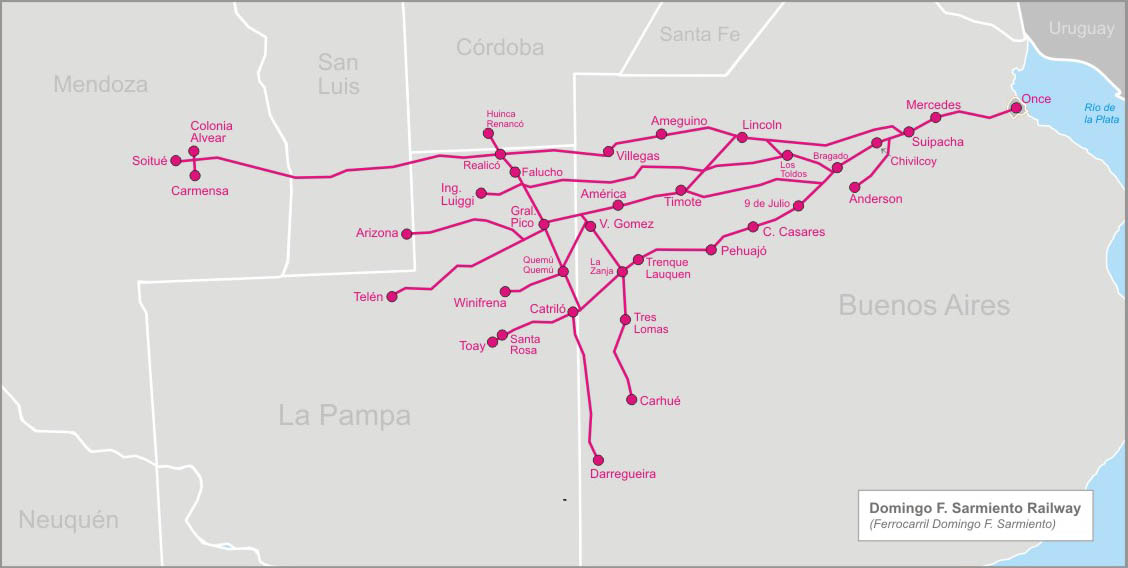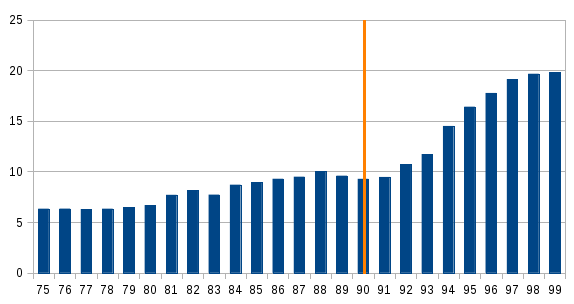|
Sarmiento Line
The Sarmiento line is a broad gauge commuter rail service in Buenos Aires Province, Argentina, run by the state-owned Trenes Argentinos since 11 September 2013. The line is part of Domingo Sarmiento Railway, running trains departing from Once de Septiembre station in the Balvanera neighborhood of Buenos Aires to the cities of Moreno, Lobos, and Mercedes in Buenos Aires Province. The 167-km long line has 40 stations. As of 2018, a total of 101,453 services had been run, with 85,946,312 passengers carried.Informe estadístico 2018 - Sarmiento on Argentina.gob.ar History [...More Info...] [...Related Items...] OR: [Wikipedia] [Google] [Baidu] |
CSR EMU (Argentina)
The CSR EMU is a series of electric multiple unit cars manufactured by CSR Corporation Limited for use on Buenos Aires' commuter rail network. As of 2015, the trains operated on three of the city's lines and 705 cars were manufactured, with each line using a different number of cars per train. They were created for use on lines electrified using both third rail and overhead lines. Background By 2013, the rolling stock of Buenos Aires' commuter rail network was ageing and deteriorating rapidly. At the same time, high-profile accidents in 2011 Flores rail crash, Flores and 2012 Buenos Aires rail disaster, Once in previous years had led the Government of Argentina, national government to revise the concession-based Railway privatisation in Argentina, railway privatisation, which was largely blamed for the deterioration of the network. The government thus decided to intervene, revoking concessions to companies such as Trenes de Buenos Aires and setting up Trenes Argentinos to manage t ... [...More Info...] [...Related Items...] OR: [Wikipedia] [Google] [Baidu] |
Domingo Sarmiento Railway
The Domingo Faustino Sarmiento Railway (FCDFS) (Spanish: Ferrocarril Domingo Faustino Sarmiento), named after the former Argentine president, statesman, educator, and author Domingo Faustino Sarmiento, is one of the six state-owned Argentine railway divisions formed after President Juan Perón's nationalisation of the Argentine railway network in 1948. The six companies were managed by Ferrocarriles Argentinos which was later broken up during the process of railway privatisation beginning in 1991 during Carlos Menem's presidency. The principal lines departed from Once railway station in Buenos Aires to the west through the provinces of Buenos Aires, La Pampa, Córdoba, San Luis and Mendoza. The railway was created after the nationalization of broad gauge lines on the British-owned company Buenos Aires Western Railway on 13 February 1947. The state-owned company created with the nationalization, Ferrocarriles Argentinos took over all the English and French railway lines. W ... [...More Info...] [...Related Items...] OR: [Wikipedia] [Google] [Baidu] |
China
China, officially the People's Republic of China (PRC), is a country in East Asia. With population of China, a population exceeding 1.4 billion, it is the list of countries by population (United Nations), second-most populous country after India, representing 17.4% of the world population. China spans the equivalent of five time zones and Borders of China, borders fourteen countries by land across an area of nearly , making it the list of countries and dependencies by area, third-largest country by land area. The country is divided into 33 Province-level divisions of China, province-level divisions: 22 provinces of China, provinces, 5 autonomous regions of China, autonomous regions, 4 direct-administered municipalities of China, municipalities, and 2 semi-autonomous special administrative regions. Beijing is the country's capital, while Shanghai is List of cities in China by population, its most populous city by urban area and largest financial center. Considered one of six ... [...More Info...] [...Related Items...] OR: [Wikipedia] [Google] [Baidu] |
Emu Mitre Line Retiro
The emu (; ''Dromaius novaehollandiae'') is a species of flightless bird endemic to Australia, where it is the tallest native bird. It is the only extant member of the genus ''Dromaius'' and the third-tallest living bird after its African ratite relatives, the common ostrich and Somali ostrich. The emu's native ranges cover most of the Australian mainland. The Tasmanian, Kangaroo Island and King Island subspecies became extinct after the European settlement of Australia in 1788. The emu has soft, brown feathers, a long neck, and long legs. It can grow up to in height. It is a robust bipedal runner that can travel great distances, and when necessary can sprint at . It is omnivorous and forages on a variety of plants and insects, and can go for weeks without eating. It drinks infrequently, but takes in copious amounts of fresh water when the opportunity arises. Breeding takes place in May and June, and fighting among females for a mate is common. Females can mate several t ... [...More Info...] [...Related Items...] OR: [Wikipedia] [Google] [Baidu] |
Unidad De Gestión Operativa Mitre Sarmiento
Unidad de Gestión Operativa Mitre-Sarmiento (UGOMS) was a temporary consortium of Argentine companies formed on 24 May 2012 by Ferrovías and Metrovías to take over the running of the Sarmiento and Mitre commuter rail lines, after concessions granted to Trenes de Buenos Aires (TBA) in 1995 for the operation of these services were revoked. History Trenes de Buenos Aires, a company formed in 1995 to take over rail concessions granted by the Argentine government, as part of railway privatisation during the presidency of Carlos Menem, operated commuter rail services over Sarmiento and Mitre lines in Buenos Aires which had previously been run by state-owned companies since nationalisation of the railways in 1948. In spite of the large state subsidies received by the company a serious decline in the standard of its services, and fatal accidents (especially, the 2012 Buenos Aires rail disaster), led to the concession for both lines being revoked in 2012 through Decree N° 793/12, ... [...More Info...] [...Related Items...] OR: [Wikipedia] [Google] [Baidu] |
2012 Buenos Aires Rail Disaster
1 (one, unit, unity) is a number, numeral, and glyph. It is the first and smallest positive integer of the infinite sequence of natural numbers. This fundamental property has led to its unique uses in other fields, ranging from science to sports, where it commonly denotes the first, leading, or top thing in a group. 1 is the unit of counting or measurement, a determiner for singular nouns, and a gender-neutral pronoun. Historically, the representation of 1 evolved from ancient Sumerian and Babylonian symbols to the modern Arabic numeral. In mathematics, 1 is the multiplicative identity, meaning that any number multiplied by 1 equals the same number. 1 is by convention not considered a prime number. In digital technology, 1 represents the "on" state in binary code, the foundation of computing. Philosophically, 1 symbolizes the ultimate reality or source of existence in various traditions. In mathematics The number 1 is the first natural number after 0. Each natural numbe ... [...More Info...] [...Related Items...] OR: [Wikipedia] [Google] [Baidu] |
Railway Privatisation In Argentina
Railway privatisation in Argentina was a process which began in 1989 under the presidency of Carlos Menem, following a series of neoliberalism, neoliberal economic reforms. This primarily consisted of breaking up the state-owned railway company Ferrocarriles Argentinos (FA) and allowing the former lines to be operated by private companies instead of the state. This policy was met with widespread criticism and proved catastrophic for the Argentine railways whose service worsened significantly in the years that followed, with entire lines closing and infrastructure deteriorating beyond repair. Privatisation was ultimately reversed in 2015 with the creation of Nuevos Ferrocarriles Argentinos. Background Since railway nationalisation in 1948, during the presidency of Juan Perón, the network had been operated by the state-owned company Ferrocarriles Argentinos (FA) which comprised the six relatively independent divisions, Domingo Sarmiento Railway, Sarmiento, General Bartolomé Mi ... [...More Info...] [...Related Items...] OR: [Wikipedia] [Google] [Baidu] |
Carlos Menem
Carlos Saúl Menem (2 July 1930 – 14 February 2021) served as the 50th president of Argentina for ten years, from 1989 to 1999. He identified as Peronism, Peronist, serving as President of the Justicialist Party for 13 years (from 1990 to 2001 and again from 2001 to 2003), and his political approach became known as Menemism. Born in Anillaco, La Rioja Province, Argentina, La Rioja, to a Syrian Argentines, Syrian family, Menem was raised as a Muslim,"Carlos Menem" ''Encyclopædia Britannica'' but later converted to Catholic Church, Roman Catholicism to pursue a political career. Menem became a Peronist during a visit to Buenos Aires. He was elected governor of La Rioja in 1973, deposed and detained following the 1976 Argentine coup d'état, and re-elected in 1983. He defeated the Buenos Aires governor Antonio Cafiero in ... [...More Info...] [...Related Items...] OR: [Wikipedia] [Google] [Baidu] |
FEMESA
Ferrocarriles Metropolitanos S.A. (also known for its acronym FEMESA) was a company set up by the Argentine government in 1991, during the presidency of Carlos Menem, to oversee the privatisation of commuter rail services within the city of Buenos Aires in Argentina Argentina, officially the Argentine Republic, is a country in the southern half of South America. It covers an area of , making it the List of South American countries by area, second-largest country in South America after Brazil, the fourt .... The company granted concessions to Metropolitano, Ferrovías, Metrovías, and Trenes de Buenos Aires for the operation of services which had previously been run by state-owned companies since the nationalisation of the railways in 1948. With its task complete, FEMESA was wound up in 1997. Overview FEMESA was created in 1991 to take over commuter rail services that had been operated by state-owned Ferrocarriles Argentinos (FA). The company was established as a ... [...More Info...] [...Related Items...] OR: [Wikipedia] [Google] [Baidu] |
Toshiba
is a Japanese multinational electronics company headquartered in Minato, Tokyo. Its diversified products and services include power, industrial and social infrastructure systems, elevators and escalators, electronic components, semiconductors, hard disk drives, printers, batteries, lighting, as well as IT solutions such as quantum cryptography. It was formerly also one of the biggest manufacturers of personal computers, consumer electronics, home appliances, and medical equipment. The Toshiba name is derived from its former name, Tokyo Shibaura Denki K.K. which in turn was a 1939 merger between Shibaura Seisaku-sho (founded in 1875) and Tokyo Denki (founded in 1890). The company name was officially changed to Toshiba Corporation in 1978. A technology company with a long history and sprawling businesses, Toshiba is a household name in Japan and has long been viewed as a symbol of the country's technological prowess post-World War II. As a semiconductor company and the i ... [...More Info...] [...Related Items...] OR: [Wikipedia] [Google] [Baidu] |
Ferrocarriles Argentinos
Ferrocarriles Argentinos (abbreviated as FA; ) was a government-owned corporation, state-owned company that managed the entire Rail transport in Argentina, Argentine railway system for nearly 45 years. It was formed in 1948 when all the private railway companies were Railway Nationalisation in Argentina, nationalised during Juan Perón's first President of Argentina, presidential term, and transformed into the ''Empresa de Ferrocarriles del Estado Argentino'' (EFEA; ). FA managed both passenger trains, passenger and freight rail transport, freight services, including long-distance and commuter rail trains in the metropolitan area of Buenos Aires. The company was broken up under the government of Carlos Menem following the Railway privatisation in Argentina, privatisation of the railways; however in 2015 the government of Cristina Kirchner revived the brand for use on state-owned railways. [...More Info...] [...Related Items...] OR: [Wikipedia] [Google] [Baidu] |







